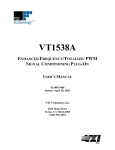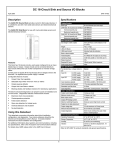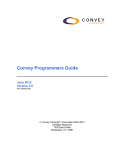Download Equitel E451 User manual
Transcript
IP intercom system October 2013 – Ed.1.0 Softwareeco Control and communication protocols EQUITEL E400 Family – Control and communications protocol i October 2013 – Ed.1.0 E400 family. Control and communications protocols Index Chapter 1. Introduction .................................................................................................................................. 1 1.1 General system description .................................................................................................................. 1 1.2 VoIP technology: a brief description .................................................................................................... 2 Chapter 2. IP intercom systems communications structure .......................................................................... 6 2.1 Calls establishment and control: EQUITEL proprietary protocol .......................................................... 7 2.1.1. Call, answer and audio control .................................................................................................. 10 2.1.1.1. DEMCALL message ............................................................................................................. 11 2.1.1.2. ACK_DEMCALL message .................................................................................................... 11 2.1.1.3. SIMCALL message .............................................................................................................. 11 2.1.1.4. ACK_SIMCALL message ...................................................................................................... 11 2.1.1.5. STARTAUDIO message ....................................................................................................... 11 2.1.1.6. ACK_STARTAUDIO message ............................................................................................... 12 2.1.1.7. STOPAUDIO message ......................................................................................................... 12 2.1.1.8. ACK_STOPAUDIO message................................................................................................. 12 2.1.2. Inputs and outputs control ........................................................................................................ 13 2.1.2.1. QRYPPORTCONFIG message .............................................................................................. 13 2.1.2.2. PPORTCONFIG message ..................................................................................................... 13 2.1.2.3. CONFIGPPORT message ..................................................................................................... 14 2.1.2.4. ACK_ CONFIGPPORT message............................................................................................ 14 2.1.2.5. WRITEPPORT message ....................................................................................................... 14 2.1.2.6. ACK_ WRITEPPORT message.............................................................................................. 15 2.1.2.7. READPPORT message ......................................................................................................... 15 2.1.2.8. PPORT message ................................................................................................................. 15 2.1.2.9. CHANGEPPORT message .................................................................................................... 16 2.1.2.10. ACK_ CHANGEPPORT message .......................................................................................... 16 2.1.3. Test and maintenance................................................................................................................ 17 2.1.3.1. QRYSYSINFO message ........................................................................................................ 17 2.1.3.2. Mensaje SYSINFO ............................................................................................................... 17 2.1.3.3. KEEPALIVE message ........................................................................................................... 18 2.1.3.4. ACK_KEEPALIVE message ................................................................................................... 18 2.1.3.5. PLAYTONE message ........................................................................................................... 18 2.1.3.6. ACK_PLAYTONE message ................................................................................................... 19 2.1.3.7. WORKINGMODE message ................................................................................................. 19 2.1.3.8. MODE message .................................................................................................................. 19 2.1.4. Communications supervision SIP ............................................................................................... 20 2.1.4.1. DEMCALLSIP message ........................................................................................................ 20 2.1.4.2. ACK_DEMCALLSIP message ............................................................................................... 20 2.1.4.3. OUTCALLRINGING message ............................................................................................... 20 2.1.4.4. ACK_ OUTCALLRINGING message ...................................................................................... 20 2.1.4.5. INCALLRINGING message ................................................................................................... 21 2.1.4.6. ACK_ INCALLRINGING message ......................................................................................... 21 2.1.4.7. CONNECTEDCALL message ................................................................................................ 21 2.1.4.8. ACK_ CONNECTEDCALL message ....................................................................................... 21 2.1.4.9. DISCONNECTEDCALL message ........................................................................................... 21 2.1.4.10. ACK_ DISCONNECTEDCALL message .................................................................................. 22 EQUITEL E400 Family – Control and communications protocol ii October 2013 – Ed.1.0 Chapter 3. Audio communication using RTP and G.711-A ........................................................................... 23 3.1 Encoding ............................................................................................................................................. 23 3.2 Decoding............................................................................................................................................. 25 Chapter 4. SIP ............................................................................................................................................... 26 4.1 Basic concepts .................................................................................................................................... 26 4.2 SIP implementation in the modules E401 and E451 .......................................................................... 27 4.2.1. Basic elements of the SIP network............................................................................................. 28 4.2.2. SIP network basic configuration ................................................................................................ 28 EQUITEL E400 Family – Control and communications protocol iii October 2013 – Ed.1.0 Chapter 1. Introduction 1.1 General system description The EQUITEL modules E401 and E451 have been conceived to be used in telephony, intercom and audio distribution systems over an Ethernet/IP network, using VoIP technology standards but adapted to the particular needs of security and surveillance systems. The topology of a possible intercom network based on those modules is depicted in the scheme below: Figure 1. IP intercom scheme with E401 and E451 modules EQUITEL E400 Family – Control and communications protocol Page 1 October 2013 – Ed.1.0 On the left side of the figure it is shown an IP intercom network using E401 OEM boards. Some minimum (1) elements must be added to build, for example, an intercom with it. . On the right side we have depicted an intercom network with E451 units. Regarding the communications, each one of the modules E401 and E451 is an Ethernet device that publishes a different IP address. This way, at a software level, there is no distinction between E401 and the intercom E451. The control and supervision of the modules, the communications establishment and the vocal transmission are made through the Ethernet/IP network, each E401 or E451 being considered as a different access point (IP address + port). In order to do that, we use some protocols that are standard in some cases or proprietary of EQUITEL in others, and that have been specifically designed for this application. This document describes the control, supervision and communication process with EQUITEL E400 modules from the communication system point of view. We stress especially all the aspects relating to the proprietary protocol mentioned above. As an example of use of the communications and control system, EQUITEL has developed a demo application to control several E401 or E451 and to send the audio from a computer. 1.2 VoIP technology: a brief description VoIP technology encompasses several international standards regulating the audio transmission over IP networks. A VoIP based telephony system can be highly complex but the basic operating theory is simple. In this paragraph we will give a short description of the basis in which this technology is founded on. Our aim is to provide a better understanding of the use we have given in our IP intercom system. We are going to put a very simple example that will explain all the necessary concepts when using this technology in the systems object of this paper. Figure 2. Minimum necessary elements for a VoIP network In the Figure 2 it is represented the most basic IP telephone network, consisting of three elements: two telephones and a PBX. Next we are going to describe the steps to take till a vocal communication between two telephones can be established. Step 1: Register At the most basic level, the PBX keeps a list with the IP telephones existing in the network and offers the capability of putting them in contact. Each telephone must be registered with the PBX and it must refresh this register periodically so that the (1) For a more detailed description of this system, please check specific documentation for E401, “E401 user manual”. EQUITEL E400 Family – Control and communications protocol Page 2 October 2013 – Ed.1.0 telephone list in the network in constantly updated, as well as its characteristics. The most important characteristic of a telephone that the PBX must know is its IP address, for it has to associate it to a determined identifying name (extension name) In the example in Figure 3 we want to associate the extension 100 to the telephone on the left side, while the telephone on the right is going to be assigned the 200. Both telephones IP addresses have been assigned by a DHCP server. Both telephones must communicate their presence to the PBX as well as their IP addresses. IP network I want to register with the extension 200. My address iss 192.168.1.99 I want to register as extension 100. My address is 192.168.1.25 IP telephone 192.168.1.25 Accepted Accepted IP telephone 192.168.1.99 Switchboard (PBX) Figure 3. VoIP. Register in the PBX Both of them send a message to the PBX indicating that they wish to register with the configured extension name and IP address. Should the PBX accept this register, it will send an acknowledge message back. For a telephone to register in a PBX, it must have configured the PBX address, the corresponding extension name and, usually, an access code. This way, the PBX limits the register to some previously configured and allowed extensions. Once the PBX has the information of all the telephones in the network, it is already possible to establish a (2) vocal communication between two of them. Step 2: Call The user willing to call from one telephone to another dials the extension number and presses the call button. By doing this, the telephone sends a message to the PBX indicating that it requests to establish a communication with that extension. In this message, the telephone shows as well which are its technical characteristics (mainly, the codification types it understands, IP address and listening ports for the audio packets). Figure 4. VoIP call The PBX searches in its list the telephone belonging to that extension and sends it a message inviting to begin a conversation. This message includes the technical characteristics of the telephone that has initiated the conversation. If the telephone receiving the invitation is compatible with the sender characteristics, it accepts the (2) The current VoIP technology allows establishing calls in multiconference mode, etc which are not considered in this application. EQUITEL E400 Family – Control and communications protocol Page 3 October 2013 – Ed.1.0 invitation; the ring tone begins to sound and sends a message to the PBX. This message is resent by the PBX to the telephone that originated the call which in turn emits the tone. IP network IP Telephone 192.168.1.25 Ringing... Ringing... IP Telephone 192.168.1.99 Switchboard (PBX) Figure 5. VoIP. Waiting to answer Step 3: Answer When receiver picks up the phone, a message indicating that the conversation has been accepted is sent to the PBX, as well as the necessary data to establish the vocal communication (which codification code is accepted among the suggested by the emitter; the IP address and the port to which the audio packets must be sent). The PBX resends this message to the telephone that began the call. Figure 6. VoIP. Answer Step 4: Vocal communication From this moment on, both telephones begin to exchange the codified audio according the scheme they have previously agreed. Figure 7. VoIP. Vocal communication It is worth to mention that both telephones exchange directly the audio stream, not through the PBX. EQUITEL E400 Family – Control and communications protocol Page 4 October 2013 – Ed.1.0 Step 5: End of communication When one of the links decide to end the communication, it cuts the audio stream and sends a message to the PBX informing about this. Figure 8. VoIP. End of communication In all this process there are two parts clearly differentiated: the control of the communication establishment or session (steps 1, 2, 3 and 5) and the vocal communications (step 4). The messages format and the data between the units are fixed by several RFCs industrial standards (3) Communications establishment There are currently several open standards: SIP, H.323,… as well as proprietary protocols from other manufacturers such as Cisco, etc. The most widely used and the simplest to implement may be SIP, defined under RFC 3261 standard. It is rather easy to find nowadays commercial telephones and PBX supporting this protocol. This document has not the purpose of describing the functioning of the SIP protocol although we will see in Chapter 4 that the units E401 and E451 implement a small part of it. Vocal communications In this case, the protocol we use is always RTP, defined under RFC 3550 standard. This protocol sets how the digitized and coded audio data are encapsulated in UDP packets. There are several audio codification methods, commonly called codecs. Each one of them has different (4) characteristics as to the quality sound and the bandwidth. The most commonly used are defined under ITU (G.711, G.722, G.723, G.726, G.728, G.729…). The most widespread and easiest to implement is G.711. It is based in digitalizing audio at 8 kilosamples per second, with 12 bits per sample. This standard is divided in two: G.711-A Law, which is used in Europe and in international links, and G.711-µLaw, more commonly used in US and Japan. The bandwidth used is 64 Kb/s. (3) RFCs are publicly accessible standards managed by IETF (Internet Engineering Task Force). They regulate the different communication protocols used nowadays in Ethernet / IP networks. www.ietf.org, www.rfc-editor.org (4) International Telecommunications Union. It is a UN body regulating the telecommunications at an international level. EQUITEL E400 Family – Control and communications protocol Page 5 October 2013 – Ed.1.0 Chapter 2. IP intercom systems communications structure EQUITEL IP intercom systems support three independent alternatives or working modes to implement the functionality of IP communication. Parallel to the chosen working mode for the audio communication, a management software implementing EQUITEL proprietary protocol is necessary, to remotely manage the auxiliary inputs and outputs of the modules E401 and E451. SIP mode with PBX As we will explain in Chapter 4, E401 and E451 can be configured in this mode since they include a SIP agent that allows them to register in any PBX supporting this protocol, and make and/or receive calls through it. The use of a controller is optional in this mode, although with its presence it is possible to supervise the calls made through the SIP protocol, in order to register them. Mode P2P-SIP In the very same Chapter 4 we describe how to configure the units E401 and E451 to use the SIP protocol without the need of a PBX. In this case we have to take into account that we lose the supervision function performed by a PBX over the links, such as calls transfers, expiry time,… Propietary mode The communication establishment is done by an EQUITEL proprietary protocol. In this chapter, we will explain it in detail. Apart from the audio communication establishment, the use of this protocol allows adding particular functionalities to these systems such as: register of events (alarms, calls, etc.), and have knowledge of its status at every moment, even if we use SIP for the communication establishment. This protocol is basically the result of encapsulating in TCP packets some simple messages for commands and answers. As far as this protocol is concerned, EQUITEL intercom systems behave as servers, accepting a connection in the port 7000. As to vocal communication itself, EQUITEL has chosen to use the codec G711-A encapsulated by the RTP protocol, due to its compatibility and ease of implementation. EQUITEL E400 Family – Control and communications protocol Page 6 October 2013 – Ed.1.0 2.1 Calls establishment and control: EQUITEL proprietary protocol According to EQUITEL proprietary protocol, the communications between the control center and the E400 modules are based on a “delivery-answer” scheme. That is, any of the links willing to communicate with the other one will send a message, and it is compulsory to receive an answer from the callee. Should the answer not be received within a previously fixed time (3 seconds by default), the unit shall make a preconfigured number of retries (3 by default), as explained in Figure 9. The messages transmitted are commands in ASCII characters or “plain text”. These messages have a very simple structure: COMMAND PARAM_1/PARAM_2/PARAM_N& • COMMAND (COMMAND): Delivery or answer order, depending on the type of the message. • PARAM_X: Each one of the parameters that a command requires. They are separated by the symbol “/”. It is not compulsory a command to require any parameters. • &: Symbol indicating the end of a delivery or answer message. Those messages are encapsulated in a TCP packet and they are sent through the IP network. There must be a computer within the network, and we shall give it the name of “controller”. It will run the software to control the IP intercom network (see Figure 1). You can use the demo application supplied by EQUITEL) Figure 9. “Delivery-answer” process in EQUITEL proprietary protocol The following tables summarize the possible actions generated or allowed by the equipments of the family E400, as well as the related answers: EQUITEL E400 Family – Control and communications protocol Page 7 October 2013 – Ed.1.0 Call, answer and audio control: Message Address Description DEMCALL E400 ACK_DEMCALL CC E400 ACK corresponding to DEMCALL SIMCALL CC E400 Simulate user call ACK_SIMCALL E400 STARTAUDIO CC ACK_STARTAUDIO E400 STOPAUDIO CC ACK_STOPAUDIO E400 CC CC E400 CC E400 CC User call ACK corresponding to SIMCALL Audio activation – conversation begins ACK corresponding to STARTAUDIO Audio deactivation – conversation ends ACK corresponding to STOPAUDIO Inputs and outputs control: Message Address Description QRYPPORTCONFIG CC I/O configuration query PPORTCONFIG E400 WRITEPPORT CC ACK_WRITEPPORT E400 READPPORT CC PPORT E400 CC I/O delivery values CHANGEPPORT E400 CC Delivery caused by an input change ACK_CHANGEPPORT CC E400 CC E400 CC E400 E400 Addresses delivery and I/O initial status Outputs writing ACK corresponding to WRITEPPORT I/O reading ACK corresponding to CHANGEPPORT Inputs and outputs configuration (only in E401): Message Address Description CONFIGPPORT CC I/O configuration change ACK_CONFIGPPORT E401 E401 CC ACK corresponding to CONFIGPPORT Test and maintenance: Message Address Description QRYSYSINFO CC Test of the system status SYSINFO E400 KEEPALIVE CC ACK_KEEPALIVE E400 PLAYTONE CC ACK_PLAYTONE E400 WORKINGMODE CC MODE E400 EQUITEL E400 Family – Control and communications protocol E400 CC Result of the test status E400 Maintenance of communications CC ACK corresponding to KEEPALIVE E400 CC E400 CC Playing an audio tone ACK corresponding to PLAYTONE Working mode query Answer to working mode Page 8 October 2013 – Ed.1.0 Communications monitoring with SIP: Message Address DEMCALLSIP E400 ACK_DEMCALLSIP CC OUTCALLRINGING E400 ACK_ OUTCALLRINGING CC INCALLRINGING E400 ACK_ INCALLRINGING CC CONNECTEDCALL E400 ACK_CONNECTEDCALL CC DISCONNECTEDCALL E400 ACK_ DISCONNECTEDCALL CC Description CC E400 User SIP call ACK corresponding to DEMCALLSIP CC Ringing, call with origin E400 (outgoing) E400 ACK corresponding to OUTCALLRINGING CC E400 CC E400 CC E400 Ringing, call with destination E400 (incoming) ACK corresponding to INCALLRINGING Beginning of SIP conversation – active audio ACK corresponding to CONNECTEDCALL End of SIP call – audio deactivated ACK corresponding to DISCONNECTEDCALL In the column “Message” it is shown only the COMMAND part of each delivery or answer message. As a reminder, they may need one or several parameters separated by “/” and they must end always with the symbol “&”. In the column “Address” it is indicated “E400 CC” for the messages going from the E400 family modules towards the controller. With “CC E400” the ones going the other way. In the following points we will describe the different messages sorted out by functionality. NOTE: In order to simplify the explanations, from now on when mentioning “E400” we will refer to both E401 (5) and E451 since regarding the protocol software, the differences are not important . (5) The sections corresponding to the intrinsic functionalities of one or another equipment will be clearly marked EQUITEL E400 Family – Control and communications protocol Page 9 October 2013 – Ed.1.0 2.1.1. Call, answer and audio control The modules E400 accept a button dedicated to user calls. The call generation process using EQUITEL proprietary protocol is shown in Figure 10. Figure 10. Call establishment process When the call button is activated, E400 sends a DEMCALL message to the controller. Should it receive the corresponding ACK, it begins to play the prerecorded message “calling tone”, and waits for the controller to activate audio. If there is no answer, the “offline tone” begins to play (twice). If there is an answer from the controller but after some configurable time (1 minute by default) the audio is not activated, the module plays the “offline tone” message (twice) and it will pass to stand-by mode. Once the audio is activated, it will remain in this status till the controller sends the deactivation order or the module E400 does not receive the refresh order within a maximum of 2 minutes. EQUITEL E400 Family – Control and communications protocol Page 10 October 2013 – Ed.1.0 2.1.1.1. DEMCALL message This message is sent from a module E400 towards the controller to indicate that the user call button has been pressed. Address: E400 CC Syntax: Command: DEMCALL Parameters: None When an E400 module sends this message, it waits to receive the corresponding ACK. 2.1.1.2. ACK_DEMCALL message This is the answer to a DEMCALL message that the controller must sent back to E400. Address: CC Syntax: Command: ACK_DEMCALL Parameters: None 2.1.1.3. E400 SIMCALL message This message is sent from the controller to E400 to force launching a call query. That is, to simulate that an user has pressed the call button. This call will be established by using the EQUITEL proprietary protocol or SIP, depending on the working mode in which the unit is configured. Address: CC E400 Syntax: Command: SIMCALL Parameters: None When a module E400 receives this message it answers back with ACK_SIMCALL. 2.1.1.4. ACK_SIMCALL message This is the message that E400 has to send back to the controller as an answer to a SIMCALL message. Address: E400 Syntax: Command: ACK_SIMCALL Parameters: None 2.1.1.5. CC STARTAUDIO message This is the message that a controller sends to activate the audio transmission and reception in the module E400. Address: CC E400 Syntax: Command: STARTAUDIO Parameters: IP address Port EQUITEL E400 Family – Control and communications protocol Page 11 October 2013 – Ed.1.0 Example: STARTAUDIO 192.168.1.10/66000& Within the message data, the controller indicates to the E400 to which IP address and port the RTP audio packets must be sent. This IP address does not have to be the controller’s. It can be any other element within the network capable of receiving coded RTP audio according the standard G.711-A and decode it. Every time that E400 receives this order, it sends the corresponding ACK_STARTAUDIO OK back, and it activates its audio circuits and RTP packets transmission and reception for a maximum of 2 minutes. In case of not being able to activate the audio, the controller will receive ACK_STARTAUDIO NOK. The E400 module port to which the RTP packets must be sent is 30000. If it is required the audio to be activated for more than 2 minutes, the controller must periodically resend the command STARTAUDIO to refresh it. This is done to avoid the E400 module to remain with the audio permanently activated should the controller not close it due to any mistake. This message can be sent to the equipment at any moment, even if there is not a previous call query. 2.1.1.6. ACK_STARTAUDIO message This is the message that the contoller has to send back to the module E400 as an answer to a STARTAUDIO message. Address: E400 CC Syntax: Command: ACK_STARTAUDIO Parameters: Command result(OK/NOK) E400 indicates in the message whether it has been possible to open correctly the audio (OK) or not (NOK). 2.1.1.7. STOPAUDIO message This is the message that a controller sends to deactivate the audio transmission and reception in E400. Address: CC E400 Syntax: Command: STOPAUDIO Parameters: None When E400 receives this order, the RTP packets delivery stops; it closes the audio circuits and sends the corresponding message to the controller: ACK_STOPAUDIO CLOSED. If when receiving the command the audio was already closed, it is sent the previous ACK. However, if it has not been possible to deactivate the audio, the message ACK_STOPAUDIO NOCLOSED is sent back. 2.1.1.8. ACK_STOPAUDIO message This is the answer of E400 to the command STOPAUDIO. Address: E400 Syntax: Command: ACK_STOPAUDIO Parameters: Audio status (CLOSED/NOCLOSED) EQUITEL E400 Family – Control and communications protocol CC Page 12 October 2013 – Ed.1.0 2.1.2. Inputs and outputs control Both E401 and E451 have some auxiliary inputs and outputs. The difference between them is the number and the possibility of configuring their address (input/output) and its initial status. • E401 has up to 18 general purpose inputs/outputs, and any of them can be configured as input or output by means of the suitable command. Please, check the specific documentation for a more detailed description of the accessibility to these inputs/outputs. • E451 has two contacts for external connections (one opto-isolated input and a relay output) In both units their inputs or outputs can be controlled through the commands that we shall describe below. Depending on the equipment, E401 or E451, the list of characters in some specific commands parameters has a different length, depending on the number of available inputs/outputs in the equipment. • In E401 the parameter length will be an 18 characters chain, corresponding to the 18 accessible pins in ascendant order: GPIO1, GPIO2, GPIO3,…., GPIO18. • In E451 the parameter length is a 2 characters chain, corresponding to its two contacts: the first one is the output and the second character is the input. 2.1.2.1. QRYPPORTCONFIG message This is the message that the controller sends to consult all the inputs/outputs initial configuration: Address: CC E400 Syntax: Command: QRYPPORTCONFIG Parameters: None In the case of E451, the two contacts configuration is fixed; the status and initial values being determined by the hardware. The use of this command will send the controller this configuration back. In the module E401, when the system starts for the first time, the available inputs/outputs have a configuration by default. It can be consulted by the controller with this command at the beginning or at any moment after having configured a change. The answer of E400 to the controller after receiving this message, containing the configuration, is PPORTCONFIG. 2.1.2.2. PPORTCONFIG message This is the answer that any module E400 sends to the command QRYPPORTCONFIG. Address: E400 CC Syntax: Command: PPORTCONFIG Parameters: Address list (I: input, O: output, X: not used) Initial status list (1, 0, X: not used / input) Exemple : [E401]: PPORTCONFIG OOOOOOOOIIIIIIIOOO/00001100XXXXXXX000& [E451]: PPORTCONFIG IO/X0& It is important to take into account that the values list (second parameter) must have the same number of elements as the address list (first parameter). However if a determined pin is configured as input its initial value will depend on the hardware connected to that pin. For each pin configured as input, the command will send an “I” address and an “X” value. EQUITEL E400 Family – Control and communications protocol Page 13 October 2013 – Ed.1.0 2.1.2.3. CONFIGPPORT message This command is valid only for E401. This is the message sent by the controller to change the available inputs/outputs configuration. This configuration will be saved. Address: CC E401 Syntax: Command: CONFIGPPORT Parameters: Address list (I: input, O: output, X: not used) Initial value list (1, 0, X: not used / input) Example: CONFIGPPORT OIIOOOXXXXXXXXXXXX/0XX000XXXXXXXXXXXX& In the example we are using 6 out of the 18 available inputs/outputs, 4 of them are configured as outputs (address “O”) with a low level initial status (value “0”) and the 2 balanced are configured as inputs (address “I”, value “X”). For the rest of inputs/outputs remaining unused, the parameters command, address and initial value are filled in with “X”. E401 changes the inputs/outputs initial configuration and sends the message ACK_CONFIGPPORT back. 2.1.2.4. ACK_ CONFIGPPORT message This command is genereted only by E401. This is the message that E401 has to send when answering to CONFIGPPORT. Address: E401 Syntax: Command: ACK_CONFIGPPORT Parameters: None 2.1.2.5. CC WRITEPPORT message This is the message that the controller sends to the controller to write remotely over the outputconfigured pins in the case of E401. Regarding E451, with this command we can write over the relay output contact. Address: CC Syntax: Command: WRITEPPORT Parameters: List of the desired value (1, 0, X: not used / input) Exemple: E400 [E401]: WRITEPPORT 0XX110XXXXXXXXXXXX& [E451]: WRITEPPORT X1& The pins configured as inputs must not be affected by this message. Therefore, as parameter we will use the value “X” for them and for the unused pins. In the case of E451 the parameter of this command will have only two characters. The first one will always be “X” since it is an input, and the second one can be either “1” or “0”depending on what we want to write in the output. E400 writes in the pins and answers with the message ACK_WRITEPPORT. EQUITEL E400 Family – Control and communications protocol Page 14 October 2013 – Ed.1.0 2.1.2.6. ACK_ WRITEPPORT message This is the message that E400 has to send back as the answer to a WRITEPPORT. Address: E400 Syntax: Command: ACK_WRITEPPORT Parameters: None 2.1.2.7. CC READPPORT message This is the message that the controller sends to consult the value of the pins configured as inputs/outputs. Address: CC E400 Syntax: Command: READPPORT Parameters: None E400 sends the message PPORT with each input/output value. 2.1.2.8. PPORT message This is the answer of E400 sends to the controller after receiving a READPPORT. Address: E400 Syntax: Command: PPORT Parameters: List of input/output values(1, 0, X: not used) Example: CC [E401]: PPORT X10XXXXXXXXXXXXX0& [E451]: PPORT 11& In the case of the pins configured as input, this message sends the read pin value. If it is an output, it sends back its final status. For the unused pins, we will use as parameter the value “X”. In the case of E451 the parameter will have two characters. The first one is the read value in the optoisolated input and the second one corresponds to the value in which we have left the relay output. EQUITEL E400 Family – Control and communications protocol Page 15 October 2013 – Ed.1.0 2.1.2.9. CHANGEPPORT message This is the message that any of the systems of the family E400 sends when detecting a change in any of their inputs. This message contains the information related to the inputs status change and furthermore it informs about the outputs status. The possibility of using or not this message is enabled by configuring the web server. It will be automatically sent to the controller every time there is a change in any of the inputs. In the following example with E401, out of the 18 available inputs/outputs 2 of them are configured as inputs and the last one as output. The status at the moment of sending the message is shown in the first parameter; Inputs: the first one at high level and the second one at low level; Output: at low level. The second parameter of the message indicates in which input there has been a status change. In the example, the delivery of the message has been originated by the first one of the two inputs. Address: E400 Syntax: Command: CHANGEPPORT Parameters: List of the current inputs/outputs status (1,0, X: not used) Example: CC List indicating which inputs have changed. All the bits will be 0 but the ones corresponding to the inputs causing the delivery of the message. [E401]: CHANGEPPORT X10XXXXXXXXXXXXXX0/010000000000000000& [E451]: CHANGEPPORT 10/10& In the case of E451, since the input is fixed, whenever there is a change the second parameter will indicate “10”. After sending this message, E400 waits for the corresponding ACK_CHANGEPPORT. 2.1.2.10. ACK_ CHANGEPPORT message This is the message that the controller has to send back to E400 as the answer to a CHANGEPPORT. Address: CC Syntax: Command: ACK_CHANGEPPORT Parameters: None EQUITEL E400 Family – Control and communications protocol E400 Page 16 October 2013 – Ed.1.0 2.1.3. Test and maintenance Within EQUITEL proprietary protocols there are several commands to make tests and help in maintenance tasks. The most important commands are the ones informing about the system status (QRYSYSINFO) and keeping the communications (KEEPALIVE). The first one checks that E400 is working fine and gives information about the system status in that moment. The second one is used to keep the communications with the equipment. Its use and expiry time are configurable through the Web server. 2.1.3.1. QRYSYSINFO message This is the message that the controller sends to enquiry about the E400 status. Address: CC E400 Syntax: Command: QRYSYSINFO Parameters: None As an answer to this message, E400 sends the controller the message SYSINFO containing its status. 2.1.3.2. Mensaje SYSINFO This is the message that E400 sends as the answer to the command QRYSYSINFO and that contains information of the equipment status. Address: E400 CC Syntax: Command: SYSINFO Parameters: Working mode (1: Protocol, 2: SIP, 3: P2P-SIP) List of the different tasks status (1: Activ, 0: Not active) Example: SYSINFO 2/111100& The second parameter has 6 possible values whose meaning is a follows, , according to the order in the list: Position Meaning 1 Application of active communication 2 Task for active SIP (in Proprietary Mode it is not active) 3 Task controlling the button “Reset Factory” active 4 Web server active 5 Audio Active 6 Tone active EQUITEL E400 Family – Control and communications protocol Page 17 October 2013 – Ed.1.0 2.1.3.3. KEEPALIVE message This is the message that the controller sends to maintain the communication established with E400. Address: CC E400 Syntax: Command: KEEPALIVE Parameters: None Once a connection between the controller and the E400 unit has been established, and the use of this command has been configured, the E400 devices wait to receive messages from the controller at a lower rhythm than the configured expiry time. Should E400 not receive them, it understands that there has been a communications failure, so it closes the connection socket and opens a new one waiting for the controller to connect again. It should be pointed out that configuring the use of “Keep-Alive” does not force the system to send always this message to update the time counter: any message will refresh the time. For example, if in the central there is a status query programmed (QRYSYSINFO) every 10 minutes and the “Keep-Alive” is configured for 15 minutes, the counter controlling the communication socket will never expire. The answer of E400 to this message will be ACK_KEEPALIVE. 2.1.3.4. ACK_KEEPALIVE message This is the message that E400 sends back to the controller, as the answer to a KEEPALIVE. Address: E400 Syntax: Command: ACK_KEEPALIVE Parameters: None 2.1.3.5. CC PLAYTONE message The family of E400 devices have available three configurable audio messages: calling.pcm: Proprietary mode: it is played when the call query has been correctly received in the control centre. SIP/P2P-SIP mode: it is played when the call has progressed correctly and it has been received by the intended recipient. ring.pcm: SIP/P2P-SIP mode: it is played when E400 receives an incoming call query. offline.pcm: It is played to indicate a failure in any of the three available working modes. We can play any of these audio prerecorded messages through this command. Address: CC Syntax: Command: PLAYTONE Parameters: Message to play (0: calling, 1: offline, 2: ring) Example: E400 PLAYTONE 1& As an answer, E400 will send the message ACK_PLAYTONE OK if the message has been successfully played, otherwise ACK_PLAYTONE NOK. EQUITEL E400 Family – Control and communications protocol Page 18 October 2013 – Ed.1.0 2.1.3.6. ACK_PLAYTONE message This is the message that E400 sends to the controller when answering to a PLAYTONE one. Address: E400 CC Syntax: Command: ACK_PLAYTONE Parameters: Command status (OK/NOK) E400 shows success or failure in playing the message with OK or NOK, respectively. 2.1.3.7. WORKINGMODE message This is the message that the controller sends to enquiry E400 about its working mode. Address: CC E400 Syntax: Command: WORKINGMODE Parameters: None E400 will answer with the message MODE, indicating its working mode. 2.1.3.8. MODE message This is the message that E400 sends when answering the WORKINGMODE command and contains information regarding the working mode in which the device is configured. Address: E400 Syntax: Command: MODE Parameters: Working mode (1: Proprietary, 2: SIP, 3: P2P-SIP) Example: CC MODE 1& EQUITEL E400 Family – Control and communications protocol Page 19 October 2013 – Ed.1.0 2.1.4. Communications supervision SIP If we configure the module E400 in any of the working modes using the SIP protocol (SIP with PBX or P2PSIP), we can implement a VoIP network without needing any controller. However, optionally we can add a controller to the network with the task of supervising the calls (to register them), and to control the auxiliary inputs and ouputs. 2.1.4.1. DEMCALLSIP message When using the SIP protocol, this message is sent from the module E400 to the control centre to indicate that the user call button has been pressed. Address: E400 CC Syntax: Command: DEMCALLSIP Parameters: None When a module E400 sends this message, it waits to receive the corresponding ACK. 2.1.4.2. ACK_DEMCALLSIP message This is the message that the controller has to answer to E400 in response to a DEMCALLSIP command. Address: CC Syntax: Command: ACK_DEMCALLSIP Parameters: None 2.1.4.3. E400 OUTCALLRINGING message This is the message sent from a module E400 to indicate that the intended recipient has received a call query, through the SIP protocol, and it is waiting for it to pick up and establish the audio communication. Address: E400 Syntax: Command: OUTCALLRINGING Parameters: Callee extension Example: CC OUTCALLRINGING 1040& After sending this message, E400 waits to receive the corresponding ACK_OUTCALLRINGING. 2.1.4.4. ACK_ OUTCALLRINGING message This is the message that the control center has to answer as a response to the message OUTCALLRINGING. Address: CC Syntax: Command: ACK_OUTCALLRINGING Parameters: None EQUITEL E400 Family – Control and communications protocol E400 Page 20 October 2013 – Ed.1.0 2.1.4.5. INCALLRINGING message This is the message sent from a module E400 to indicate that it has received an incoming call query via the SIP protocol. Address: E400 CC Syntax: Command: INCALLRINGING Parameters: None After sending this message, E400 waits to receive the corresponding ACK_INCALLRINGING. 2.1.4.6. ACK_ INCALLRINGING message This is the message that the central must send back to a module E400 when receiving the message INCALLRINGING. Address: CC Syntax: Command: ACK_INCALLRINGING Parameters: None 2.1.4.7. E400 CONNECTEDCALL message This is the message sent from a module E400 to indicate the beginning of a conversation and the audio activation. Address: E400 CC Syntax: Command: CONNECTEDCALL Parameters: None After sending this message, E400 waits to receive the corresponding ACK_CONNECTEDCALL. 2.1.4.8. ACK_ CONNECTEDCALL message This is the message that the control center has to send back to an E400 as the answer to a message CONNECTEDCALL. Address: CC Syntax: Command: ACK_CONNECTEDCALL Parameters: None 2.1.4.9. E400 DISCONNECTEDCALL message This is the message sent from any of the E400 modules to indicate the end of a conversation, using the SIP protocol, and the audio deactivation. Address: E400 CC Syntax: Command: DISCONNECTEDCALL Parameters: None After sending this message, E400 waits to receive the corresponding ACK_DISCONNECTEDCALL. EQUITEL E400 Family – Control and communications protocol Page 21 October 2013 – Ed.1.0 2.1.4.10. ACK_ DISCONNECTEDCALL message This is the message that the control center has to send back to an E400 as the answer to a message DISCONNECTEDCALL. Address: CC Syntax: Command: ACK_DISCONNECTEDCALL Parameters: None EQUITEL E400 Family – Control and communications protocol E400 Page 22 October 2013 – Ed.1.0 Chapter 3. Audio communication using RTP and G.711-A The audio communication within EQUITEL IP intercom system (E401 AND E451) uses the RTP protocol with the G.711-A encoding. This communication implies two processes: encoding and decoding. With regards to encoding, the equipments E401 and E451 send the RTP stream to the indicated IP address and port in the communication establishment phase. Depending on the unit configuration, the communication can be established in different ways: • Proprietary mode: using EQUITEL proprietary protocol, described in Chapter 2. • SIP mode with PBX: using the SIP protocol and a PBX, detailed in Chapter 4. • P2P-SIP mode: using the SIP protocol. There is no need of a PBX, as explained in Chapter 4. As to decoding, the systems of the family E400 always answer to the input UDP port 30000. In this chapter we shall describe the encoding and decoding processes used in our systems. 3.1 Encoding The process of encoding and encapsulating the audio is shown in the following block diagram: Figure 11. G711 coding and RTP encapsulation Roughly, the process is as follows: The input audio is digitized at 8000 samples per second. Each sample must have a minimum resolution of 12 (6) bits . These audio samples are stored in a buffer with capacity for up to 160 samples, the equivalent to 20 milliseconds of audio. Every time we have a 160 samples packet, the G.711-A coding is applied, consisting basically in converting each 12bits PCM sample in an 8 bits data according to the following table: (6) If we take a computer as an example, it is usual to take samples at 16 bits and with the proper treatment they are reduced till 12 bits. EQUITEL E400 Family – Control and communications protocol Page 23 October 2013 – Ed.1.0 PCM sample (without sign) P10 0 0 0 0 0 0 0 1 P9 0 0 0 0 0 0 1 A P8 0 0 0 0 0 1 A B P7 0 0 0 0 1 A B C P6 0 0 0 1 A B C D P5 0 0 1 A B C D - G.711-A data (without sign) P4 0 1 A B C D - P3 A A B C D - P2 B B C D - P1 C C D - P0 D D - G6 0 0 0 0 1 1 1 1 G5 0 0 1 1 0 0 1 1 G4 0 1 0 1 0 1 0 1 G3 A A A A A A A A G2 B B B B B B B B G1 C C C C C C C C G0 D D D D D D D D To obtain the value of the G.711-A data corresponding to a sample, we take the module of the latter (11 bits P10…P0) and, according to the value of the most relevant bits, we will take the corresponding 4 bits (A, B, C, D) to form the G.711-A data. If the PCM sample is negative, the resulting G.711-A data will also be negative, so it will be coded in 2's complement. As we can see in the table, the samples with a lower value are encoded without reducing their resolution. However, for samples with a higher module we have disregarded the less significant bits. Finally, the obtained data must be masked making a XOR operation bit by bit with the number 0x55 (01010101b). After obtaining the 160 data G.711-A (160 bytes) we proceed to form the RTP packet that will be sent the network, using the UDP protocol. The RTP protocol, defined in RFC 3550, is a communication standard for audio and video over IP networks, allowing the receivers to compensate the jitter and the packets disorder that can occur in the network. It consists basically on the standardization of the packets length, the information delivery order and a header based on the content type we need to encapsulate. In our case, the packets must be formed as follows to send encoded audio according to G.711-A: Bit 0 V 7 P X CC 15 M 23 Sequence PT 31 TimeStamp SSRC D0 D1 D2 D3 D158 D159 … D158 D157 The header is formed by 4 32-bit words containing the following fields: V (Version): 2 bits representing RTP protocol version in use. It has to be always equal to 2. P (Padding bit): Bit indicating if the packet has been filled in with void data due to aligning purposes. In our case it must always be 0. X (Xtension bit): Bit indicating whether the header is extended. This applies to other type of content. In our case it has to be always 0. CC (CSRC Count): 4 bits showing the number of CSRC fields following the header. The CSRC fields are not used in this type of contents so these 4 bits will always be 0. M (Market): A bit whose use is defined according to the type of content. In the case of audio in G.711-A, this bit is always 0. PT (Payload Type): 7 bits indicating the data transported by the RTP packet. It is the one allowing the EQUITEL E400 Family – Control and communications protocol Page 24 October 2013 – Ed.1.0 (7) receivers to distinguish the packet content. These field values are normalized by IANA . For the audio encoded in G.711-A the value for this field is 8. Sequence: 16 bits number identifying each packet consecutively. It is used by the receiver to reorder the packets if necessary. TimeStamp: This is a 32-bit time stamp indicating the transmission moment of each packet since the session initiation. The units in which time is measured depend on the type of content. For G.711-A the units are increments of 125 µs. Therefore, in each transmitted RTP packet we have to increase this data in 160 with respect to the previous one. SSRC (Synchronization Source Identifier): Number of 32 bits used to synchronize different RTP streams if necessary. In our case it can be any number since there is no synchronization of any kind. Next we attach the data forming the audio packet content in its natural order; that is, the first is the older one and the last one is the most recent. This way the RTP packet will have a 172 bytes length. This packet is sent using the UDP protocol. 3.2 Decoding The decoding process is summarized in the block diagram of Figure 12. (8) The RTP packets received in the port 30000 are stored in a FIFO type buffer to compensate the jitter introduced in the network. Furthermore, we can take advantage of this buffer to reorganize the packets if necessary. The higher the buffer capacity, the more robust will be the receiver against jitter. However, the more audio latency will be introduced as well. Every 20 milliseconds we extract a packet from this buffer which is decoded to obtain the corresponding PCM samples, and they are sent to the digital-analogue converter. The decoding is made applying the opposite process to codification we have just seen. Figure 12. RTP reception and G711-A decoding (7) Internet Assigned Numbers Authority. (8) The time that one data packet takes to travel till destination is not fixed as it depends on several factors. The packets coming out from a transmitter with a constant rhythm do not reach the receiver at the same rhythm. This fluctuation in the frequency is known as “jitter”. EQUITEL E400 Family – Control and communications protocol Page 25 October 2013 – Ed.1.0 Chapter 4. SIP The SIP protocol is defined under the standard RFC 3261 and encompasses the initiation, management, modification and finalization of multimedia services exchange sessions among several participants, through digital networks, telephone calls, video-conferences, delivery of multimedia contents… The most common application of this protocol nowadays is the management of VoIP calls (in the point 1.2 we have given a brief overview of this technology). EQUITEL has incorporated a SIP agent to allow the equipments of the E400 family to receive and make calls directly to IP telephones and, if the suitable PBX is used, even to analogue or mobile phones. Both the board E401 and the intercom E451 have the possibility of using this protocol instead of EQUITEL’s proprietary one by configuring the equipment in SIP mode with PBX or in P2P-SIP mode. SIP is a very complex protocol encompassing several aspects. In the modules E401 and E451 we have focused on the application for VoIP calls management. We have implemented a small part of the protocol that has allowed us to develop an easy functionality for answering incoming calls and making calls to the configured device, by means of pressing an available input (“push-to-call”). In this chapter we will explain briefly some basic concepts to understand the application of this protocol in the E400 intercom system. 4.1 Basic concepts In a basic SIP managed VoIP network we find the following main components: User Agent It is any device capable of beginning or accepting any SIP session. It can be an IP telephone, a videotelephone, a computer running the appropriate application, an E401 board, an E451 intercom, etc. Registrar It is a server that maintains the physical location (IP address) of every network user agent. Each user agent has a logical address that remains unchanged, and a physical one that may change. When connecting to the network, each agent must register in the server to inform of its logical address, and the physical one at that moment. In the most typical example of the SIP protocol (IP telephony), the logical addresses are the equivalent to their extension numbers. Each telephone (user agent) has a fixed extension but its IP address may change (it can be assigned dynamically with the DHCP protocol, for example) In this case, the PBX contains a registrar agent maintaining the equivalence list between each extension number and its corresponding IP addresses in the network. Furthermore, this PBX may authorize each user agent to register or not by using security passwords, with the aim of accepting only the authorized users. Once an agent is registered, the rest can access it through the registrar server using the assigned logical address (extension). The link between the logical address and the physical one within the registrar agent has a fixed expiry date. If the subscription is not renewed before that date, it expires and makes the agent inaccessible to the rest of the units. SIP server A SIP server puts in contact an agent with another one, either as an intermediary by exchanging the messages between itself and the agents (proxy server), or indicating to the others which is each agent delivery address (redirect server) EQUITEL E400 Family – Control and communications protocol Page 26 October 2013 – Ed.1.0 In summary, it is the one in charge of establishing the sessions and putting in contact one link with another in communication. In the example of IP telephony, the registrar and SIP servers are within the same element, normally the SIP switchboard or PBX. VoIP Gateway When elements of different technologies are to interface, we have to use Gateways. For example, a Gateway may serve as the link between a VoIP network and a public switched telephone network to make calls between analogue and IP telephones. Once again, in the typical application of IP telephony, this element lies within the PBX. 4.2 SIP implementation in the modules E401 and E451 For the purposes of the SIP protocol, the modules E401 and E451 behave as user agents as any IP telephone would do. In EQUITEL IP intercom systems we have implemented a part of the SIP protocol to make a simple functionality of answering an incoming call, and a push-button based call request, associated to an available input. Next we will show a simple network that will serve as the base to explain more in detail how to use the SIP protocol in our intercom systems. Figure 13. Basic network for using the SIP protocol SIP mode with PBX Both modules can register with the PBX, in which we have to configure a specific extension for each one of the E401 or E451 we wish to use. EQUITEL E400 Family – Control and communications protocol Page 27 October 2013 – Ed.1.0 Once the modules E401 and E451 have been properly configured in the switchboard, register with it and we will be able to make / receive calls directly to / from IP telephones. (9) they have to The advantage of working in this mode against P2P-SIP that we will explain now is given by the PBX itself, since it allows a much better communications management with supervision tasks, calls transfers, etc. P2P-SIP mode If any of the E400 intercom modules is configured in this working mode, a PBX is not needed. Once the destination extension is configured in the modules E401 and E451, it is possible to make/receive calls directly to/from IP telephones not requiring registering in a PBX. It is also possible to make calls directly between the intercoms E400. 4.2.1. Basic elements of the SIP network As we can see in the Figure 13, the basic elements of a SIP based intercom network are as follows: • One or several intercoms E451 (E401 boards). • A PBX (in P2P-SIP mode it is not necessary). • An IP telephone (it can be substituted by another computer with a SOFT_PHONE software). For this example we use a software based PBX central, “3CX phone system”. A free demo can be downloaded from the web site http://www.3cx.es/. Nevertheless there are many other similar solutions in the market. Optionally, we can add a controller to the network, consisting on a computer with the necessary software. It is possible to use the demo application supplied by EQUITEL. When configured in the SIP working mode it supervises the established calls to register them and controls the auxiliary inputs and outputs. 4.2.2. SIP network basic configuration The procedure to configure a network using E451s or E401s and the SIP protocol is as follows (10) : SIP mode with PBX 1. Set the PBX so as to register as many extensions as E451 intercoms we wish to use and another extension for the telephone. 2. Set the IP telephone to register with the PBX with the assigned extension. It is very important the telephone to have the capacity of using the audio codec G711-A, the one employed by E451 units. 3. Set the E451 intercoms to register with the PBX with their assigned extension. 4. Configure in each one of the E451 units the device extension you wish to call in a “push-to-call” application. We can transfer the call to another telephone by setting the PBX, should the configured extension in E451 not answer. 5. Once all the units are configured, we have to check in the PBX that all of them are actually registered and capable of communicating. (9) Consult each model particular documentation for a more detailed description of the SIP agent setting process. (10) The PBX and telephone particular setting processes are beyond the scope of this document. Please refer to E401 and E451 particular documentation to know more about their configuration. EQUITEL E400 Family – Control and communications protocol Page 28 October 2013 – Ed.1.0 P2P-SIP mode 1. Set the IP telephone, not requiring registering with a PBX, assigning it an extension and the (11) . It is important the telephone to have the capacity of required data to make a call understanding the audio codec G711-A, which is the one used by E451. 2. Set the E451, assigning an extension to each one of them. 3. In each one of the E451 units, configure the callee device extension and IP address in a “push-tocall” application. In this mode it is not possible to transfer calls. 4. If all the units are correctly configured, they are capable of communicating. Communication process When activating one of the E451 intercoms push button, the communication establishment request begins. The vocal communication between the telephone and the intercom may begin when picking up the phone. Likewise, the telephone can communicate with any of the E451 just by calling the corresponding extension. E451 is ready to emit an incoming call warning tone. The call is answered by pressing the button and thus begins the vocal communication with the telephone. Any of both links can close he communication: from the telephone or from E451 by pressing the button. As we have seen, the E451 button or the corresponding input in E401 have a triple functionality: call, answer a call and hang up. (11) The aim of this document is not to explain the settings of all the IP telephones available in the market. Please consult the each manufacturer for that. EQUITEL E400 Family – Control and communications protocol Page 29










































